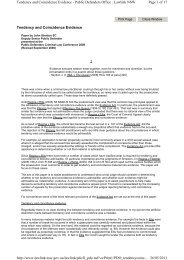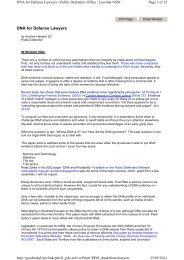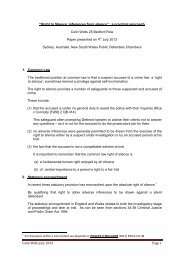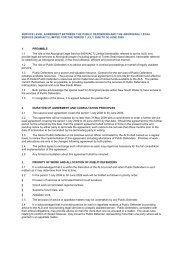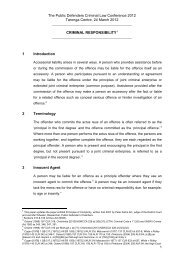Expert Evidence, by Dina Yehia SC - The Public Defenders
Expert Evidence, by Dina Yehia SC - The Public Defenders
Expert Evidence, by Dina Yehia SC - The Public Defenders
You also want an ePaper? Increase the reach of your titles
YUMPU automatically turns print PDFs into web optimized ePapers that Google loves.
[730] I do not believe it is necessary to resolve this issue in these proceedings. However,<br />
as I have said, to my mind the book which A/Prof Cross published has the consequence<br />
that his opinion on any controversial matter has minimal if any weight: see Pan<br />
Pharmaceuticals Ltd (in liq) v Selim [2008] FCA 416 at [157] (Emmett J).<br />
…<br />
[758] A/Prof Cross took upon himself the role of investigator and became an active<br />
participant in attempting to prove that the applicant had committed murder. Rather than<br />
remaining impartial to the outcome and offering his independent expertise to assist the<br />
Court he formed the view from speaking with some police and Mr Byrne and from his own<br />
assessment of the circumstances that the applicant was guilty and it was his task to assist<br />
in proving his guilt. In my opinion if the book and the speech had been available to the<br />
defence and the extent of A/Prof Cross' partiality made apparent, his evidence would have<br />
been assessed <strong>by</strong> the jury to be of little if any evidentiary value on any controversial issue.<br />
GILHAM v R [2012] NSWCCA 131<br />
<strong>The</strong> applicant was convicted at trial of the murder of his parents on 28 August 1993. Mr and Mrs Gilham died<br />
as a result of multiple stab wounds. <strong>The</strong>ir bodies were then set alight causing a fire in part of the house.<br />
Christopher Gilham was also found dead. He had sustained 17 stab wounds. <strong>The</strong> applicant maintained that<br />
on entering the house he saw that his parents had been murdered <strong>by</strong> his brother, Christopher. <strong>The</strong> applicant<br />
then stabbed his brother, killing him in anger over what he had done.<br />
In August 1993 the applicant was charged with the murder of his brother but pleaded guilty to manslaughter<br />
on the basis of the version he had given to police. In June 1995 the Coroner found that Mr and Mrs Gilham<br />
died as a result of stab wounds inflicted <strong>by</strong> Christopher Gilham. Following a renewed police investigation in<br />
1999 a second inquest was held. <strong>The</strong> inquest was terminated in April 2000, the Deputy State Coroner<br />
referring the matter to the DPP.<br />
It was not until 21 February 2006 that an ex-officio indictment was filed in the Supreme Court charging the<br />
applicant with the murder of his parents. On 28 November 2008 he was found guilty. On 11 March 2009 he<br />
was sentenced to life imprisonment on each count.<br />
<strong>The</strong> Crown case against the applicant was a circumstantial one. For present purposes it is convenient to set<br />
out the areas of expert evidence relied upon <strong>by</strong> the Crown which formed some of the appeal grounds:<br />
(i)<br />
<strong>Evidence</strong> of James Munday – Fire Investigator<br />
<strong>The</strong> Crown called Mr Munday to give evidence about the speed at which and the form in which the fire had<br />
spread. For that purpose Mr Munday conducted a number of experiments captured on DVD. During the voir<br />
dire, it became apparent that there were a number of variables any one of which could have affected the size<br />
and rate of speed of the fire.<br />
At trial the applicant had submitted that the content of the DVD recordings were irrelevant or, alternatively,<br />
should be excluded pursuant to section 137 <strong>Evidence</strong> Act. <strong>The</strong> trial judge admitted the DVDs after an<br />
agreed editing process.<br />
On appeal, the Court held that the evidence ought not to have been admitted:<br />
[173] <strong>The</strong> judge's directions based upon the evidence given <strong>by</strong> Mr Munday suggest that<br />
the experiments had very little, if any, probative value, in the absence of a sufficient<br />
correlation between what the evidence proved was likely to have occurred, and the<br />
experiments shown in the videos. However, as we have earlier noted, there was either<br />
insufficient evidence to prove a number of the variables upon which the experiments were<br />
based, or alternatively, the variables which were taken into account produced results which<br />
may or may not have replicated what actually occurred.<br />
[174] In those circumstances, the jury were left to do the best they could with a range of<br />
experiments which may or may not have coincided with the events that occurred.<br />
14



